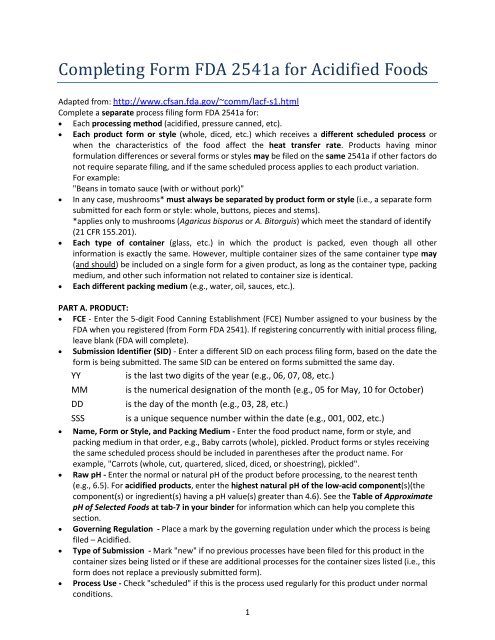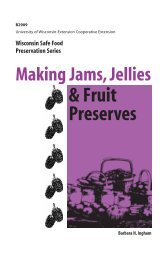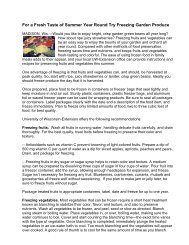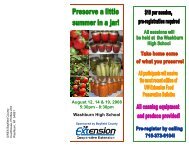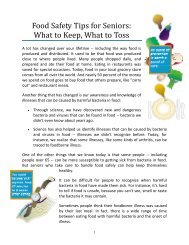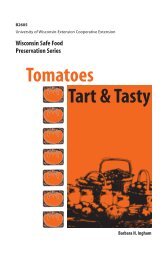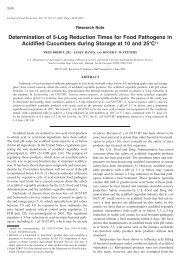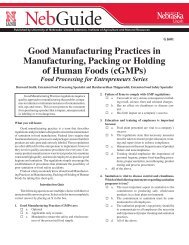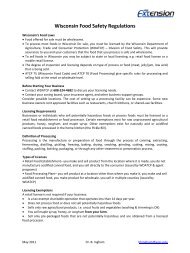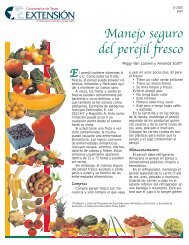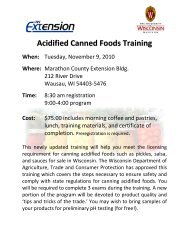Completing Form FDA 2541a for Acidified Foods
Completing Form FDA 2541a for Acidified Foods
Completing Form FDA 2541a for Acidified Foods
- No tags were found...
Create successful ePaper yourself
Turn your PDF publications into a flip-book with our unique Google optimized e-Paper software.
<strong>Completing</strong> <strong>Form</strong> <strong>FDA</strong> <strong>2541a</strong> <strong>for</strong> <strong>Acidified</strong> <strong>Foods</strong>Adapted from: http://www.cfsan.fda.gov/~comm/lacf-s1.htmlComplete a separate process filing <strong>for</strong>m <strong>FDA</strong> <strong>2541a</strong> <strong>for</strong>:• Each processing method (acidified, pressure canned, etc).• Each product <strong>for</strong>m or style (whole, diced, etc.) which receives a different scheduled process orwhen the characteristics of the food affect the heat transfer rate. Products having minor<strong>for</strong>mulation differences or several <strong>for</strong>ms or styles may be filed on the same <strong>2541a</strong> if other factors donot require separate filing, and if the same scheduled process applies to each product variation.For example:"Beans in tomato sauce (with or without pork)"• In any case, mushrooms* must always be separated by product <strong>for</strong>m or style (i.e., a separate <strong>for</strong>msubmitted <strong>for</strong> each <strong>for</strong>m or style: whole, buttons, pieces and stems).*applies only to mushrooms (Agaricus bisporus or A. Bitorguis) which meet the standard of identify(21 CFR 155.201).• Each type of container (glass, etc.) in which the product is packed, even though all otherin<strong>for</strong>mation is exactly the same. However, multiple container sizes of the same container type may(and should) be included on a single <strong>for</strong>m <strong>for</strong> a given product, as long as the container type, packingmedium, and other such in<strong>for</strong>mation not related to container size is identical.• Each different packing medium (e.g., water, oil, sauces, etc.).PART A. PRODUCT:• FCE - Enter the 5-digit Food Canning Establishment (FCE) Number assigned to your business by the<strong>FDA</strong> when you registered (from <strong>Form</strong> <strong>FDA</strong> 2541). If registering concurrently with initial process filing,leave blank (<strong>FDA</strong> will complete).• Submission Identifier (SID) - Enter a different SID on each process filing <strong>for</strong>m, based on the date the<strong>for</strong>m is being submitted. The same SID can be entered on <strong>for</strong>ms submitted the same day.YYis the last two digits of the year (e.g., 06, 07, 08, etc.)MM is the numerical designation of the month (e.g., 05 <strong>for</strong> May, 10 <strong>for</strong> October)DD is the day of the month (e.g., 03, 28, etc.)SSS is a unique sequence number within the date (e.g., 001, 002, etc.)• Name, <strong>Form</strong> or Style, and Packing Medium - Enter the food product name, <strong>for</strong>m or style, andpacking medium in that order, e.g., Baby carrots (whole), pickled. Product <strong>for</strong>ms or styles receivingthe same scheduled process should be included in parentheses after the product name. Forexample, "Carrots (whole, cut, quartered, sliced, diced, or shoestring), pickled".• Raw pH - Enter the normal or natural pH of the product be<strong>for</strong>e processing, to the nearest tenth(e.g., 6.5). For acidified products, enter the highest natural pH of the low-acid component(s)(thecomponent(s) or ingredient(s) having a pH value(s) greater than 4.6). See the Table of ApproximatepH of Selected <strong>Foods</strong> at tab-7 in your binder <strong>for</strong> in<strong>for</strong>mation which can help you complete thissection.• Governing Regulation - Place a mark by the governing regulation under which the process is beingfiled – <strong>Acidified</strong>.• Type of Submission - Mark "new" if no previous processes have been filed <strong>for</strong> this product in thecontainer sizes being listed or if these are additional processes <strong>for</strong> the container sizes listed (i.e., this<strong>for</strong>m does not replace a previously submitted <strong>for</strong>m).• Process Use - Check "scheduled" if this is the process used regularly <strong>for</strong> this product under normalconditions.1
PART B. PROCESSING METHOD:<strong>Acidified</strong> Products - If 21 CFR 108.25 and 114 was marked as the governing regulation, mark "acidified"and complete all applicable in<strong>for</strong>mation as follows:• Maximum Equilibrium pH - Enter the maximum equilibrium pH (upper limit) of the finished productafter acidification, measured within 24 hours after processing, to the nearest tenth (e.g., 4.2).Recheck Section A. Product to assure that the raw pH (Item (4)) was also completed properly.• Method of Acidification - Enter the method of acidification (e.g., direct batch acidification, directaddition, etc.).• Acidifying Agent - Enter acidifying agent(s), e.g., citric acid, acetic acid (5% vinegar), lemon juice,tomato sauce, etc.• Pasteurization Method - If a heat treatment (e.g., pasteurization) is recommended by the processsource as part of the scheduled process, enter the type of treatment, such as boiling water canning,hot fill hold, etc.• Preservative Used - If a preservative is used along with pH control, specify the preservative (e.g.,sodium benzoate, potassium sorbate, etc.) and the concentration (%) of the finished product. If nopreservative is used, enter N/A.• Process Establishment Source - NOTE: If more than one process source is listed, the process(es)must have been established jointly by the listed sources. Otherwise, use a separate <strong>for</strong>m <strong>for</strong> eachprocess source.o Enter the name of the process source (organization, company, or individual, etc.) whichscientifically established the scheduled process(es) and the type of document containing theprocess recommendations (i.e., letter, bulletin, etc.). Use the following guidelines in makingentries:-Limit entries to 30 characters,-If the process was established by your firm, enter your firm's name.-For universities, enter name of university followed by the name of an individual (if appropriate).ooDate Last EstablishedProcess Recommendations Attached? If you are attaching a copy of the processrecommendation from the process establishment source, check "YES". Otherwise check "NO".C. CRITICAL FACTORS. Mark (x) <strong>for</strong> ALL critical factors. If none were specified, Mark (x) "None "D. SCHEDULED PROCESS.Container Dimensions - Enter the dimensions of each container size which is used <strong>for</strong> the product listedIN ENGLISH UNITS (inches and sixteenths). <strong>Form</strong>s submitted without conversion to English units will bereturned. Use a separate line <strong>for</strong> each different container size and its process parameters orcharacteristics, numbering each line sequentially (1, 2, etc.) in the "Cont. No." column. Do not leaveblank lines between container sizes.Proper Measuring Techniques <strong>for</strong> Cylindrical ContainersWhen measuring unusually shaped cylindrical containers, always measure the widest part of thecontainer. The measurements must be from the outside edge of the container.2
IMPORTANT: Report measurements in inches and sixteenths using the standard <strong>for</strong>mat: 0405 x 0311 <strong>for</strong>a container which is 4 5/16 inches tall, and 3 11/16 inches wide.SCHEDULED PROCESS• Step No. - Enter "1" unless: This is a multiple step process.• Temp (°F) - For <strong>Acidified</strong> food processes, check "Fill” and enter that temperature (in °F) if any of theabove have been specified by the process establishment source. If none are applicable, enter "N/A".• Process Time (Minutes) - For <strong>Acidified</strong> food processes, check "Process Time", or "Hold Time” andenter the time in minutes to the nearest hundredth if any of the above have been specified by theprocess establishment source.• Sterilization Temp (°F) - For <strong>Acidified</strong> food processes check "Process Temp" and enter the minimumprocess temperature in F to the nearest whole degree if a sterilizer processing temperature hasbeen specified by the process establishment source. Otherwise, check "N/A".• Least Sterilizing Value of the Scheduled Process1. Enter the following in<strong>for</strong>mation.Check - other F-valueDeath Rate (z): 19.5°FRef. Temp (T): xxx°F (Enter the processing temperature identified in your scheduled process)The target F value (minutes) is the time needed to achieve a 5-log reduction in E. coli O157:H7 at thereference temperature. Use the following table to complete <strong>for</strong>m <strong>2541a</strong>.*Temp (°F) Target F-value(min)Temp (°F) Target F-value(min)Temp (°F) Target F-value(min)140 12.7 154 2.4 168 0.5142 10.1 156 1.9 170 0.4144 7.9 158 1.6 172 0.3146 6.3 160 1.2 174 0.2148 4.9 162 0.9 176 0.2150 3.9 164 0.7 178 0.1152 3.1 166 0.6 180 0.1*What this means: For a hot-fill product like salsa with a fill temperature of 160°F, hold the productat 160°F <strong>for</strong> 1.2 minutes to achieve the target lethality (5-log reduction); at a fill temperature of180°F, hold the product <strong>for</strong> 0.1 min (6 seconds) to reach the target lethality.2. Enter the reference temperature ,target F value, and publication reference in the Commentssection:T ref = xxx°FTarget F=xx min[In the above example, T ref =160°F, Target F = 1.2 min]Reference: Breidt, F., K.P. Sandeep, and F.M. Arritt. May 2010. Use of linear models <strong>for</strong> thermalprocessing of acidified foods. Food Protection Trends. 30:268-272.Be sure to sign and date the <strong>for</strong>m!Revised: August 20103


